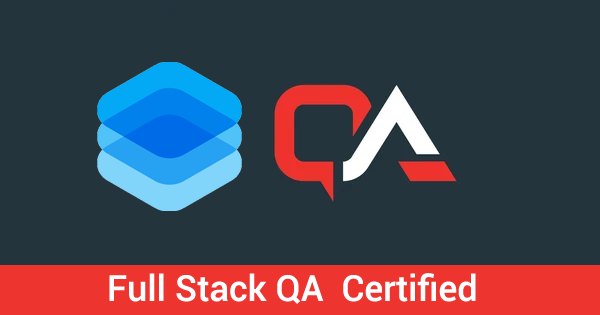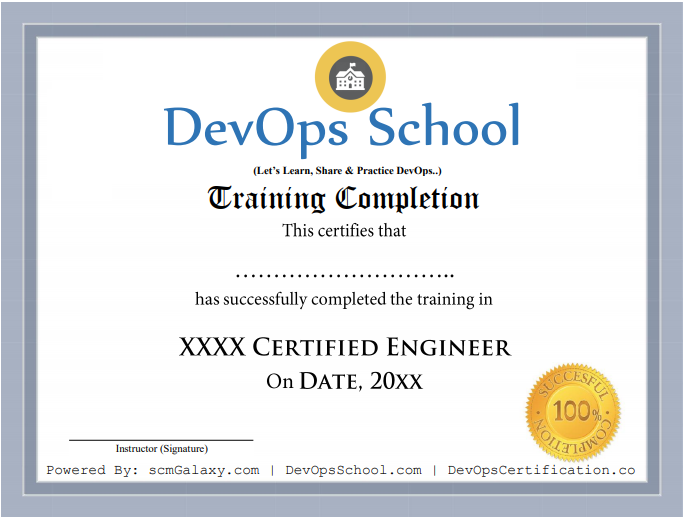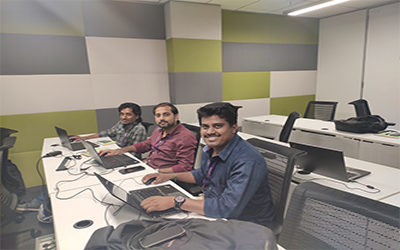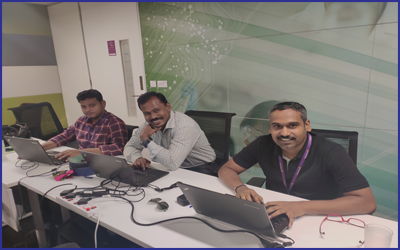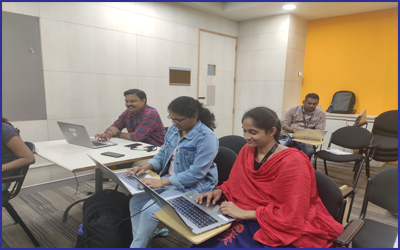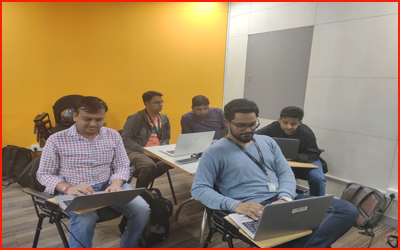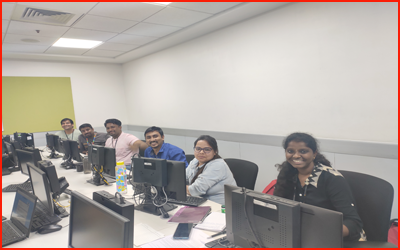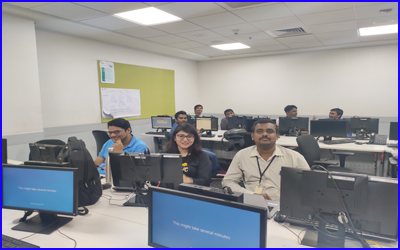Full Stack QA Certified Professional (FSQCP)
Course Duration
60 hours
Live Projects
01
Certification
Industry recognized
Training Format
8000+
Certified Learners
15+
Years Avg. faculty experience
40+
Happy Clients
4.5/5.0
Average class rating
ABOUT FULL STACK QA COURSE
We have introduced this course named "Full Stack QA" which is suitable for anyone who wants to break into software testing domain or for experienced QA, QA Leads, Quality Managers who want in-depth understanding of Software Testing in Full Stack want to keep Arrive. This course will help you learn new skills, new tools, and new testing methods that are critical to running proper QA in the modern software development process.
A full-stack QA professional is comfortable working across all application layers and will be familiar with the bulk of its functionality. They will think about many different aspects of product quality, such as functionality, usability, performance, safety, etc.
The course will explain the new roles and responsibilities of the testers as well as the new mindset adopted by the testers and the entire team who work together in the daily activities of a full stack team during the iteration, as well as discuss the various testing levels . Wish. An important aspect of automation is the full-stack approach. Get started on your Full Stack Testing certification now.
I hope this course will be helpful for those who are looking for a change in their testing career and also for those who are planning to start their career in software testing.
Typical skills/responsibilities of a Full Stack QA Professional
Here are some skills required to be a full-stack QA professional:
- Strong knowledge of Agile methodology, software QA methodologies, tools, and processes.
- Ability to write test scenarios and test cases for manual testing.
- Ability to write unit and integration tests.
- Understanding of testing frameworks.
- Writing automation test cases on tools like Selenium WebDriver.
- Experience in API automation such as Postman.
- Experience with Continuous Integration and Continuous Delivery tool such as Jenkins.
- Experience in Bug tracking and reporting.
The same concept applies to quality assurance engineers. It will describe an all-rounder who can perform various types or levels of testing such as manual testing, automation testing, security testing, performance testing, etc.
Instructor-led, Live & Interactive Sessions
Duration |
Mode |
Agenda |
|---|---|---|
60 Hours |
Online (Instructor-led) |
Full Stack QA Developers |
Course Price at
24,999/-
[ Fixed - No Negotiations]
Full Stack QA Training
Full Stack QA
Through a combination of interactive sessions and hands-on practice, this course will provide you or your team with the understanding and proficiency needed to integrate QA as an effective, high-performing part of your Full Stack process.
Project
After the training you will get one real time scenario based project where you will work on the real requirements and you will perform real time testing from beginning to the end.
Interview
As part of this, you would be given complete Full Stack Testing Interview sets of questions which help you to to prepare for Full Stack QA interviews.
Agenda of the Full Stack QA Training Download Curriculum
- Lets Understand about Software Development Model
- Overview of Waterfall Development Model
- Challenges of Waterfall Development Model
- Overview of Full Stack Development Model
- Challenges of Full Stack Development Model
- Requirement of New Software Development Model
- Understaning a existing Pain and Waste in Current Software Development Model
- What is DevOps?
- Transition in Software developement model
- - Waterfall -> Full Stack -> CI/CD -> DevOps -> DevSecOps
- Understand DevOps values and principles
- Culture and organizational considerations
- Communication and collaboration practices
- Improve your effectiveness and productivity
- DevOps Automation practices and technology considerations
- DevOps Adoption considerations in an enterprise environment
- Challenges, risks and critical success factors
- What is DevSecOps?
- Lets Understand DevSecOps Practices and Toolsets.
- What is SRE?
- Lets Understand SRE Practices and Toolsets.
- List of Tools to become Full Stack Developer/QA/SRE/DevOps/DevSecOps
Microservices Fundamentals
Microservices Patterns
- Choreographing Services
- Presentation components
- Business Logic
- Database access logic
- Application Integration
- Modelling Microservices
- Integrating multiple Microservices
What and When to test
Preparing for deployment
Monitoring Microservice Performance
Tools used for Microservices Demo using container
Keeping it simple
- Avoiding Breaking Changes
- Choosing the right protocols
- Sync & Async
- Dealing with legacy systems
- Testing
- Installing CentOS7 and Ubuntu
- Accessing Servers with SSH
- Working at the Command Line
- Reading Files
- Using the vi Text Editor
- Piping and Redirection
- Archiving Files
- Accessing Command Line Help
- Understanding File Permissions
- Accessing the Root Account
- Using Screen and Script
- Overview of Hypervisor
- Introduction of VirtualBox
- Install VirtualBox and Creating CentOS7 and Ubuntu Vms
- Understanding Vagrant
- Basic Vagrant Workflow
- Advance Vagrant Workflow
- Working with Vagrant VMs
- The Vagrantfile
- Installing Nginx
- Provisioning
- Networking
- Sharing and Versioning Web Site Files
- Vagrant Share
- Vagrant Status
- Sharing and Versioning Nginx Config Files
- Configuring Synced Folders
- Introduction of AWS
- Understanding AWS infrastructure
- Understanding AWS Free Tier
- IAM: Understanding IAM Concepts
- IAM: A Walkthrough IAM
- IAM: Demo & Lab
- Computing:EC2: Understanding EC2 Concepts
- Computing:EC2: A Walkthrough EC2
- Computing:EC2: Demo & Lab
- Storage:EBS: Understanding EBS Concepts
- Storage:EBS: A Walkthrough EBS
- Storage:EBS: Demo & Lab
- Storage:S3: Understanding S3 Concepts
- Storage:S3: A Walkthrough S3
- Storage:S3: Demo & Lab
- Storage:EFS: Understanding EFS Concepts
- Storage:EFS: A Walkthrough EFS
- Storage:EFS: Demo & Lab
- Database:RDS: Understanding RDS MySql Concepts
- Database:RDS: A Walkthrough RDS MySql
- Database:RDS: Demo & Lab
- ELB: Elastic Load Balancer Concepts
- ELB: Elastic Load Balancer Implementation
- ELB: Elastic Load Balancer: Demo & Lab
- Networking:VPC: Understanding VPC Concepts
- Networking:VPC: Understanding VPC components
- Networking:VPC: Demo & Lab
- What is Virtualization?
- What is Containerization?
- Why Containerization?
- How Docker is good fit for Containerization?
- How Docker works?
- Docker Architecture
- Docker Installations & Configurations
- Docker Components
- Docker Engine
- Docker Image
- Docker Containers
- Docker Registry
- Docker Basic Workflow
- Managing Docker Containers
- Creating our First Image
- Understading Docker Images
- Creating Images using Dockerfile
- Managing Docker Images
- Using Docker Hub registry
- Docker Networking
- Docker Volumes
- Deepdive into Docker Images
- Deepdive into Dockerfile
- Deepdive into Docker Containers
- Deepdive into Docker Networks
- Deepdive into Docker Volumes
- Deepdive into Docker Volume
- Deepdive into Docker CPU and RAM allocations
- Deepdive into Docker Config
- Docker Compose Overview
- Install & Configure Compose
- Understanding Docker Compose Workflow
- Understanding Docker Compose Services
- Writing Docker Compose Yaml file
- Using Docker Compose Commands
- Docker Compose with Java Stake
- Docker Compose with Rails Stake
- Docker Compose with PHP Stake
- Docker Compose with Nodejs Stake
- Overview of Jira
- Use cases of Jira
- Architecture of Jira
- Installation and Configuraration of Jira in Linux
- Installation and Configuraration of Jira in Windows
- Jira Terminologies
- Understanding Types of Jira Projects
- Working with Projects
- Working with Jira Issues
- Adding Project Components and Versions
- Use Subtasks to Better Manage and Structure Your Issues
- Link Issues to Other Resources
- Working in an Full Stack project
- Working with Issues Types by Adding/Editing/Deleting
- Working with Custom Fields by Adding/Editing/Deleting
- Working with Screens by Adding/Editing/Deleting
- Searching and Filtering Issues
- Working with Workflow basic
- Introduction of Jira Plugins and Addons.
- Jira Integration with Github
- Exploring Confluence benefits and resources
- Configuring Confluence
- Navigating the dashboard, spaces, and pages
- Creating users and groups
- Creating pages from templates and blueprints
- Importing, updating, and removing content
- Giving content feedback
- Watching pages, spaces, and blogs
- Managing tasks and notifications
- Backing up and restoring a site
- - Add/Edit/Delete new users
- - Adding group and setting permissions
- - Managing user permissions
- - Managing addons or plugins
- - Customizing confluence site
- - Evaluation options for Confluence
- - Supported platforms
- - Installing Confluence on Windows
- - Activating Confluence trial license
- - Finalizing Confluence Installation
- Introduction
- Setup Java Development Environment
- Java Language Fundamental
- Arrays and Loops
- Java Methods
- Conditioning and Looping in Java
- Exception Handling
- Basics of Oops in Java
- Create a Java Package using Jar
- Creating Basic Java Web Based application
- Create a Java Package using War
- Deploy Web App in Tomcat Environment
- Interpreted languages
- Advantages and disadvantages
- Downloading and installing
- Which version of Python
- Where to find documentation
- Running Python Scripts
- String types: normal, raw and Unicode
- String operators and expressions
- Math operators and expressions
- Writing to the screen
- Command line parameters
- Reading from the keyboard
- Flow Control
- Using the interpreter interactively
- Running standalone scripts under Unix and Windows
- Getting Started
- Indenting is significant
- The if and elif statements
- while loops
- Using lists
- Using the for statement
- The range() function
- Sequence Data
- list methods
- Strings are special kinds of lists
- tuples
- sets
- Dictionaries
- Defining Functions
- Opening a text file
- Reading text files
- Raw (binary) data
- Using the pickle module
- Writing to a text file
- Dictionaries and Sets
- Formal parameters
- Global versus local variables
- Passing parameters and returning values
- Working with Files
- Creating dictionaries
- Creating dictionaries
- Fetching keys or values
- Testing for existence of elements
- Deleting elements
- Errors and Exception Handling
- Understanding version control
- The history of Git
- About distributed version control
- Who should use Git?
- Installing Git on a Mac
- Installing Git on Windows
- Installing Git on Linux
- Configuring Git
- Exploring Git auto-completion
- Using Git help
- Initializing a repository
- Understanding where Git files are stored
- Performing your first commit
- Writing commit messages
- Viewing the commit log
- Exploring the three-trees architecture
- The Git workflow
- Using hash values (SHA-1)
- Working with the HEAD pointer
- Adding files
- Editing files
- Viewing changes with diff
- Viewing only staged changes
- Deleting files
- Moving and renaming files
- Using Git with a Real Project
- Introducing the Explore California web site
- Initializing Git
- Editing the support phone number
- Editing the backpack file name and links
- Undoing working directory changes
- Unstaging files
- Amending commits
- Retrieving old versions
- Reverting a commit
- Using reset to undo commits
- Demonstrating a soft reset
- Demonstrating a mixed reset
- Demonstrating a hard reset
- Removing untracked files
- Using .gitignore files
- Understanding what to ignore
- Ignoring files globally
- Ignoring tracked files
- Tracking empty directories
- Referencing commits
- Exploring tree listings
- Getting more from the commit log
- Viewing commits
- Comparing commits
- Branching overview
- Viewing and creating branches
- Switching branches
- Creating and switching branches
- Switching branches with uncommitted changes
- Comparing branches
- Renaming branches
- Deleting branches
- Configuring the command prompt to show the branch
- Merging code
- Using fast-forward merge vs. true merge
- Merging conflicts
- Resolving merge conflicts
- Exploring strategies to reduce merge conflicts
- Fast Forward Merge
- Three way Merge
- Rebasing
- Saving changes in the stash
- Viewing stashed changes
- Retrieving stashed changes
- Deleting stashed changes
- Using local and remote repositories
- Adding a remote repository
- Creating a remote branch
- Cloning a remote repository
- Tracking remote branches
- Pushing changes to a remote repository
- Fetching changes from a remote repository
- Merging in fetched changes
- Checking out remote branches
- Pushing to an updated remote branch
- Deleting a remote branch
- Enabling collaboration
- A collaboration workflow
- Setting up aliases for common commands
- Using SSH keys for remote login
- Exploring integrated development environments
- Exploring graphical user interfaces
- Understanding Git hosting
- Conclusion
- Lightweight tags
- Annotated tags
- Signed Tags
- Create tags in Git
- Create tags in Stash
- Checkout tags in Git
- How to view tags
- How to checkout tags
- What is Gradle?
- Why Gradle?
- Installing and Configuring Gradle
- Build Java Project with Gradle
- Build C++ Project with Gradle
- Build Python Project with Gradle
- Dependency Management in Gradle
- Project Structure in Gradle
- Gradle Tasks
- Gradle Profile and Cloud
- Gradle Properties
- Gradle Plugins
Artifactory
- Artifactory Overview
- Understanding a role of Artifactory in DevOps
- System Requirements
- Installing Artifactory in Linux
- Using Artifactory
- Getting Started
- General Information
- Artifactory Terminology
- Artifactory Repository Types
- Artifactory Authentication
- Deploying Artifacts using Maven
- Download Artifacts using Maven
- Browsing Artifactory
- Viewing Packages
- Searching for Artifacts
- Manipulating Artifacts
Packer
- What is Packer?
- Save What is Packer?
- Installing Packer
- Save Installing Packer
- The Packer workflow and components
- Save The Packer workflow and components
- The Packer CLI
- Save The Packer CLI
- Select an AWS AMI base
- Save Select an AWS AMI base
- Automate AWS AMI base build
- Save Automate AWS AMI base build
- Using build variables
- Save Using build variables
- Provision Hello World
- Save Provision Hello World
- Provision a basic site
- Save Provision a basic site
- Simplify provisioning with a config tool
- Save Simplify provisioning with a config tool
- Use ansible to install the webserver
- Save Use ansible to install the webserver
- Debugging
- Save Debugging
- Use Ansible modules to harden our image
- Save Use Ansible modules to harden our image
- Baking a Jenkins image
- Save Baking a Jenkins image
- Validate Packer templates
- Save Validate Packer templates
- Create a manifest profile
- Save Create a manifest profile
- Testing
- Save Testing
- CI pipeline
- Save CI pipeline
- Flask Overview
- Flask Installign and Configuring
- Flask Understanding Environment
- Flask Understanding Application
- Flask Understanding Routing
- Flask Understanding Variable Rules
- Flask Understanding URL Building
- Flask Understanding HTTP Methods
- Flask Understanding Templates
- Flask Understanding Static Files
- Flask Understanding Request Object
- Flask Understanding Sending Form Data to Template
- Flask Understanding Cookies
- Flask Understanding Sessions
- Flask Understanding Redirect & Errors
- What is Selenium?
- What are the components of Selenium?
- Understanding Why selenium is better than other tools?
- Advantages and disadvantage of Selenium
- What are the basic commands in Selenium?
- Commands to open and close a browser
- Get Commands
- Navigation Commands
- Switch Commands
- Interacting with WebElement
- Understanding Types & Techniques of Locators to locate WebElements?
- Understanding What are Web Elements?
- How to customize Xpath to Locate various WebElements?
- Hands – on example with “NewTours” Web Application to experience Selenium Automation Execution.
- Different types of Alerts – Simple, Confirmation and Prompt alert.
- Handling modal dialog box and pop-ups
- Handling various windows using switch window commands
- Working with Drag and Drop of an element
- Understanding how we can handle element in drop down list.
- Working with multiple selection of elements from a list of options
- Experiencing the Mouse Hovering action.
- Experiencing the Keyboard and Mouse actions using the Action and Actions Class.
- Introduction
- Fortify Software System Requirements
- Fortify Static Code Analyzer Installation Guide
- Analysis Process Overview
- Translating Java Code
- Translating .NET Code
- Translating C and C++ Code
- Translating JavaScript Code
- Translating Ruby Code
- Translating ABAP Code
- Translating Code for Mobile Platforms
- Translating Apex and Visualforce Code
- Translating Flex and ActionScript
- Translating COBOL Code
- Translating Other Languages
- Integrating into a Build
- Command-Line Interface
- Command-Line Utilities
- Troubleshooting
- Filtering the Analysis
- Scan Wizard
- Sample Files
- Configuration Options
- Fortify Static Code Analyzer Performance Guide
- Introduction
- Performance Improvement Tips
- Scan Quality and Performance
- Optimizing FPR File
- Monitoring Long Running Scans
- Troubleshooting
- Java API
- Command Line
- Apache Ant
- Apache Maven
- Jenkins
- Introduction
- About NGINX
- NGINX vs Apache
- Test your knowledge
- Server Overview
- Installing with a Package Manager
- Building Nginx from Source & Adding Modules
- Adding an NGINX Service
- Nginx for Windows
- Test your knowledge
- Understanding Configuration Terms
- Creating a Virtual Host
- Location blocks
- Variables
- Rewrites & Redirects
- Try Files & Named Locations
- Logging
- Inheritance & Directive types
- PHP Processing
- Worker Processes
- Buffers & Timeouts
- Adding Dynamic Modules
- Test your knowledge
- Headers & Expires
- Compressed Responses with gzip
- FastCGI Cache
- HTTP2
- Server Push
- HTTPS (SSL)
- Rate Limiting
- Basic Auth
- Hardening Nginx
- Test your knowledge
- Let's Encrypt - SSL Certificates
- Introduction of Configuration Management
- Understand the problems in Servers config management
- Finding out the solutions for Servers config management
- What is Ansible
- Benefits of Ansible
- Ansible Vs Chef Vs Puppet
- Ansible Architecture
- How Ansible Works?
- Introduction to YAML
- Setup Ansible Developement Environment
- Introduction of Ansible Commands lines
- Introduction of Ansible Modules
- Introduction of Ansible Play
- Introduction of Ansible Playbook
- Introduction of Ansible Configurations
- Introduction of Ansible Inventory
- Writing a Play Using Modules
- Writing a Playbook
- Writing a Inventory
- Running a Playbook in Local Server
- Running a Playbook in Remote Server
- The Setup Module
- The Command Module
- The Expect Module
- The RAW Module
- The Script Module
- The Shell Module
- The File Module
- The SELinux Module
- The SEBoolean Module
- The Copy Module
- The Cron Module
- The Include Module
- The Mount Module
- The User Module
- The Group Module
- The Mail Module
- The Git Module
- The Apt Module
- The Yum Module
- The Package Module
- The Service Module
- Deep Dive into Ansible Playbooks
- Target Section
- Variable Section
- Task Section
- Handler Section
- Lookups
Outlining Your Playbook
- Handlers in Ansible
- Variables in Ansible
- Register in Ansible
- Includes vs. Imports in Ansible
- Conditions in Ansible
- Loops in Ansible
- Blocks in Ansible
- Files operations in Ansible
- Templating(Jinja2) in Ansible
- Basic Error Handling in Playbooks
- Basic Torubleshooting in Ansibles
- Using Hosts and Groups
- Behavioral Inventory Parameters
- Host Variables
- Group Variables
- Groups of Group
- Groups of Group Variables
- Splitting Out Host and Group Specific Data
- Using Hosts and Groups
- Behavioral Inventory Parameters
- Host Variables
- Group Variables
- Groups of Group
- Groups of Group Variables
- Splitting Out Host and Group Specific Data
- Understand Role Directory Structure
- Using Ansible Roles
- Ansible Role Duplication and Execution
- Ansible Role Default Variables
- Ansible Role Dependencies
- Embedding Modules and Plugins In Roles
- Ansible Role Search Path
- Use cases of Ansible Vault
- Creating Encrypted Files
- Editing Encrypted Files
- Rekeying Encrypted Files
- Encrypting Unencrypted Files
- Decrypting Encrypted Files
- Viewing Encrypted Files
- Using Ansible Vault
- Introduction
- What's the Scenario?
- Terraform Components
- Demo Time!
- Introduction
- What's the Scenario?
- Terraform Provisioners
- Terraform Syntax
- Demo Time!
- Introduction
- Terraform State and Update
- What's the Scenario?
- Data Type and Security Groups
- Demo Time!
- Introduction
- What's the Scenario?
- Terraform Providers
- Terraform Functions
- Demo: Intro and Variable
- Demo: Resource Creation
- Demo: Deployment and Terraform Console
- Demo: Updated Deployment and Terraform Commands
- What is Continuous Integration
- Benefits of Continuous Integration
- What is Continuous Delivery
- What is Continuous Deployment
- Continuous Integration Tools
- Jenkins Vs TeamCity Vs Bamboo
- History of Jenkins
- Release of Jenkins
- Jenkins Vs Jenkins Enterprise
- Prerequisites
- Installing Jenkins using Yum
- Installing Jenkins using Apt
- Installing Jenkins using MSI
- Installing Jenkins using Tomcat
- Installing as a Service
- Starting and Stopping Jenkins
- Understand Freestyle Project
- Freestyle General Tab
- Freestyle Source Code Management Tab
- Freestyle Build Triggers Tab
- Freestyle Build Environment
- Freestyle Build
- Freestyle Post-build Actions
- Manage Jenkins
- My Views
- Credentials
- People
- Build History
- Simple Java and Maven Based Application
- Simple Java and Ant Based Application
- Simple Java and Grovy Based Application
- Simple DOTNET and MSBuild Based Application
- Simple C++ using Batch Application
- Manually Building
- Build Trigger based on fixed schedule
- Build Trigger by script
- Build Trigger Based on pushed to git
- Jenkins Jobs parameterised
- Execute concurrent builds
- Jobs Executors
- Build Other Projects
- Build after other projects are built
- Throttle Builds
- Installing a Plugin
- Plugin Configuration
- Updating a Plugin
- Plugin Wiki
- Top 20 Useful Jenkins Plugins
- Using Jenkins Pluginss Best Practices
- Adding a Linux Node
- Adding a Windows Nodes
- Nodes Management using Jenkins
- Jenkins Nodes High Availability
- Jira
- Git
- SonarQube
- Maven
- Junit
- Chef
- Puppet
- Ansible
- Docker
- AWS
- Jacoco
- Coverity
- Selenium
- Gradle
- Terraform
- Packer
- Junit Report
- SonarQube Reports
- Jacoco Reports
- Coverity Reports
- Selenium Reports
- Test Results
- Cucumber Reports
- Adding a Linux Node
- Adding a Windows Nodes
- Nodes Management using Jenkins
- Jenkins Nodes High Availability
- CI Build Pipeline & Dashboard
- Email Notification
- Advance Email Notification
- Slack Notification
- Security in Jenkins
- Authorization in Jenkins
- Authentication in Jenkins
- Managing folder/subfolder
- Jenkins Upgrade
- Jenkins Backup
- Jenkins Restore
- Jenkins Command Line
PROJECT
As part of this projects, we would help student to have first hands experience of real time software project development planning, coding, deployment, setup and monitoring in production from scratch to end. We would also help students to visualize a real development environment, testing environment and production environments. The goal of this project. Project technology would be Java, Pythong and DOTNET and based on microservices concept..
Interview
As part of this, You would given complete interview preparations supports until you clear a interview and get onboarded with organziation including demo inteview and guidance. More than 50 sets of Interview KIT would be given including various project scnario of the projects.
OUR COURSE IN COMPARISON
| FEATURES | DEVOPSSCHOOL | OTHERS |
|---|---|---|
| Lifetime Technical Support | ||
| Lifetime LMS access | ||
| Top 20 Tools | ||
| Real time scenario projects | ||
| Step by Step Web Based Tutorials | ||
| Training Slides |
In today's organization, you are pretty much guaranteed to work with full-stack QA engineers. A QA engineer working on all aspects of quality and using different testing methods to test their application is called a full-stack QA engineer.
Full-stack QA engineers have good growth opportunities as test architects in the future due to their experience in almost all parts of the software testing process.
- Our Full Stack QA course has comprehensive skills-building curriculum that teaches all the necessary skills for all team members involved in the testing and QA process.
- From the initial stage of test planning, test case development, unit/integration testing, system/acceptance testing to verification and product release our courses will teach best practices to keep pace with the sophistication of today’s software development.
- This cours will help you to build essential skills and strengthen them with techniques and tools that will optimize and maximize your performance with your Full Stack projects.
- Our Full Stack QA course is designed for both freshers who are looking to pursue a career and experienced professionals including Testing engineers, Developers, QA leads, QA managers, Project managers or anyone who wants to improve their testing skills and wants to work on Full Stack methodology.
- As the software development process has been changed and moved to Full Stack process, its really important to make yourself ready and this is the right course which will help you to prepare with an edge above the others who are still not trained in it.
- As an expereienced professional you will learn completely about how to do the Full Stack testing and you will be well equipped to shift in such teams with ease and confidence and for those who are already working in Full Stack but never done a formal training, our Full Stack QA course will prepare you and make you well euipped to be an effective Full Stack QA or lead. It will also help you to track and correct wrong implementation of Full Stack practices if happening, in your team.
- Our program contains structured content in each section, dynamic presentation with real-time demonstration and hands-on practical approaches.
- We will always be available for any assistance or concerns through email and forums.
- You will get trained by 15 years+ professionals who has excellent functional knowledge and expertise.
- Lifelong Access - Pay fees one time and get access to all the learning materials including self-learning videos lifetime.
- You will get practical learning experience working in an organization with live project work and examples.
- Strong knowledge of Agile methodology, software QA methodologies, tools, and processes.
- Ability to write test scenarios and test cases for manual testing.
- Ability to write unit and integration tests.
- Understanding of testing frameworks.
